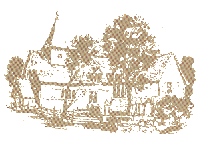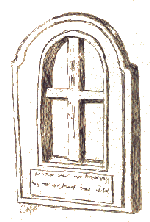A Short History of Frimley
In 666 AD the hamlet was
included in a grant of land to the Benedictine monks of St. Peter’s
Abbey, Chertsey, and in the 10th century the Abb ey
established the Frimley Monastery, a modest settlement of lay monks.
‘Frymley Chapel’ is the earliest church mentioned in a document of
1549. It contained "John Stevens Chauntery" where mass could
be said; but the inhabitants of Frimley were required to attend service
four miles away in their Mother Church at Ash and tithes were paid to
Ash. Frimley became a separate parish in 1866. The present church
possesses a chalice and paten of late Elizabethan workmanship dated
1586. The earliest surviving Frimley register contains baptisms from
1590 and marriages and burials from 1606.
ey
established the Frimley Monastery, a modest settlement of lay monks.
‘Frymley Chapel’ is the earliest church mentioned in a document of
1549. It contained "John Stevens Chauntery" where mass could
be said; but the inhabitants of Frimley were required to attend service
four miles away in their Mother Church at Ash and tithes were paid to
Ash. Frimley became a separate parish in 1866. The present church
possesses a chalice and paten of late Elizabethan workmanship dated
1586. The earliest surviving Frimley register contains baptisms from
1590 and marriages and burials from 1606.
The Benedictine settlement has long
since vanished and the association with Chertsey ended at the
Dissolution in 1537. Chertsey Abbey was demolished and the Frymley
Chapel may have suffered the same fate, for a new chapel was consecrated
in 1606. This was served by a visiting curate who was paid£10 p.a. A
clerk who was also sexton was paid £4 p.a. In 1820, when the curate
became resident, the inhabitants had increased to 1,284 and this was
attributed to the "improved neighbourhood of the military college
at Sandhurst". But the heath was still "villainous" and
highwaymen who had been the scourge of travelers in the 17th century
still lurked in such areas. In 1850 burglars broke into the parsonage, a
red-brick building still standing but now housing Roman Catholic clergy;
the resident curate was shot and died of his wounds. The execution of
the to men involved in this crime was one of the last public hangings.
Return
to top of page
Frimley Old Church 1606 - 1826
 The
former church is described as of "Timber studded with brick"
and was probably tiles as entries in parish accounts refer to the
carriage of 1,200 tiles from Farnham. In 1818 it was in a bad state of
repair and it was decided to build a larger, more permanent structure. A
petition to the Lord of the Manor (dated 24 10 1818) stating the case
for a new Church says — "we beg leave to solicit a small quantity
of land of a very small value contiguous to the present churchyard for
the erection of the new building and the extension of the burying
ground", from which it appears that the old chapel stood to the
north of the present building at the corner of Field Lane.
The
former church is described as of "Timber studded with brick"
and was probably tiles as entries in parish accounts refer to the
carriage of 1,200 tiles from Farnham. In 1818 it was in a bad state of
repair and it was decided to build a larger, more permanent structure. A
petition to the Lord of the Manor (dated 24 10 1818) stating the case
for a new Church says — "we beg leave to solicit a small quantity
of land of a very small value contiguous to the present churchyard for
the erection of the new building and the extension of the burying
ground", from which it appears that the old chapel stood to the
north of the present building at the corner of Field Lane.
The Old Cottage in Field Lane was once a small Inn,
the Queen's Head, nicknamed the Drum and Monkey. It is listed as a
beerhouse in the 1841 Census and it may even be on the site of the old
Church brewhouse. Certainly it would have been used by mourners seeking
refreshment; burial corteges using the side gate leading from Field
Lane.
The Present Church, built in 1825 to replace the
smaller one, is of local sandstone. The Nave with its three galleries
can hold 450 people. The West end of the building was restored in 1887;
and the clock and bells bestowed in 1930. The organ was presented by a
Mrs Johnson in memory of her husband and brother-in-law. In 1997 the
steel framework supporting was completely refurbished.
Return
to top of page
Memorials
On the north wall are two small brasses from the
former church; one to Richard Beard and one to his daughter, Margaret.
At the West end is a tablet to the Rev G. E. Hollest, murdered by
burglars who broke into his parsonage in 1850. At the East end William
Bassett is commemorated, as also is Dame Ethel Smyth, Doctor of Music,
whose family home was at Frimhurst, Frimley Green. She later moved to
"One Oak" on the Portsmouth Road, which building is now a
Public House.
Return
to top of page
Documents
In the vestibule is a framed report on the former
church, made when rebuilding was considered in the early 1800's. there
is also information on the first chapel and John Stevens' Chantry, taken
from "A History of Frimley" by Henry Aldred (1896), which can
be seen in its entirety in the Camberley Reference Library.
Return
to top of page
Churchyard
 This
is extensive and contains some monuments of interest. One wooden
graveboard survives, though in poor condition; and outside the East
window is the tomb of the Tekell family, one-time Lords of the Manor.
Near the far end of the brick wall on the North side of the churchyard
is the low, red marble tomb of Bret Harte, the American poet who spent
the last years of his life in Frimley. On the way to his grave, notice
that of Admiral Sturdee, with a wooden cross of timber from the Victory,
framed in a stone arch.
This
is extensive and contains some monuments of interest. One wooden
graveboard survives, though in poor condition; and outside the East
window is the tomb of the Tekell family, one-time Lords of the Manor.
Near the far end of the brick wall on the North side of the churchyard
is the low, red marble tomb of Bret Harte, the American poet who spent
the last years of his life in Frimley. On the way to his grave, notice
that of Admiral Sturdee, with a wooden cross of timber from the Victory,
framed in a stone arch.
Return
to top of page
Recent Churches
In 1860 Frimley was separated from Ash and became a
parish. St. Peter's Church served the area which stretched from Yorktown
to Mytchett. This was later sub-divided into two new parishes to serve
the increasing population. In 1964 St. Francis' was built as a daughter
church to St. Peter's to meet the needs of that part of the parish
stretching into Heatherside. It was dedicated on Sunday, 4th October,
1964, — the Feast of St. Francis.
Return
to top of page
The Church and the People
Before travel was made easy the population of a
village changed little. The same families lived there for generations.
In the Frimley Registers and Rent Rolls the names of Cobbett, Knight,
Finch, Budd, Over, Elsley, Goddard, Bristowe and many others constantly
recur and some are still in the Parish. These families formed a
community almost self-contained for it had its own craftsmen with wide
and adaptable skills. The blacksmith in Frimley also made clocks and
there was a carpenter, shoemaker, miller, harness maker, potter, broom
maker, and so on. Travelling Packmen. or occasional visits to Farnham
Market, would supply other necessities.
The heart of this community was the Parish Church,
which throughout English history has not only been concerned with the
spiritual and moral welfare of its people, but it has also been the
centre of secular life; providing relief in distress, work for the
unemployed and even entertainment. Church officials elected periodically
to carry out these duties were not only Church-wardens and a Tything
man, but Overseers of the Poor, Constable, Way-wardens and Ale Connor.
The Ale Connor had at one time brewed the ale for the
neighbourhood, but it is possible that by the 16th Century he was
concerned only with the control of its strength and price.
Ale or beer was the normal drink; bread, cheese and a
little meat were the staple diet of country folk. Some vegetables were
grown by cottagers and probably a pig was kept.
The Poor Laws prescribed a poor rate payable by
parishioners in proportion to the value of their property. This rate was
approved by local magistrates. At some time an almshouse or workhouse
was built on the Poor Allotment for lodging "paupers" and
maintained from the Poor Rate.
The Overseers of the Poor,  were "substantial householders" elected at a Vestry meeting,,
who collected the rates and dispensed relief subject to decisions of
members of the Vestry. This might be in the form of money, clothing or
material for clothing, or merely bread. For many some employment was
provided. Usually women would make articles of clothing and men would do
labouring work; such as digging ground or graves, cutting and carting
turves for fuel and cutting stone for building.
were "substantial householders" elected at a Vestry meeting,,
who collected the rates and dispensed relief subject to decisions of
members of the Vestry. This might be in the form of money, clothing or
material for clothing, or merely bread. For many some employment was
provided. Usually women would make articles of clothing and men would do
labouring work; such as digging ground or graves, cutting and carting
turves for fuel and cutting stone for building.
Return
to top of page